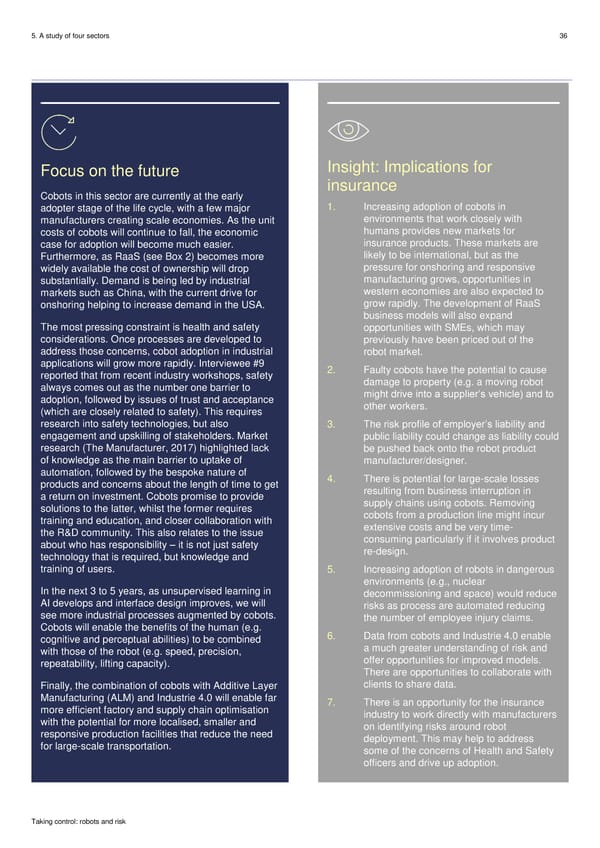5. A study of four sectors 36 Focus on the future Insight: Implications for Cobots in this sector are currently at the early insurance adopter stage of the life cycle, with a few major 1. Increasing adoption of cobots in manufacturers creating scale economies. As the unit environments that work closely with costs of cobots will continue to fall, the economic humans provides new markets for case for adoption will become much easier. insurance products. These markets are Furthermore, as RaaS (see Box 2) becomes more likely to be international, but as the widely available the cost of ownership will drop pressure for onshoring and responsive substantially. Demand is being led by industrial manufacturing grows, opportunities in markets such as China, with the current drive for western economies are also expected to onshoring helping to increase demand in the USA. grow rapidly. The development of RaaS business models will also expand The most pressing constraint is health and safety opportunities with SMEs, which may considerations. Once processes are developed to previously have been priced out of the address those concerns, cobot adoption in industrial robot market. applications will grow more rapidly. Interviewee #9 2. Faulty cobots have the potential to cause reported that from recent industry workshops, safety damage to property (e.g. a moving robot always comes out as the number one barrier to might drive into a supplier’s vehicle) and to adoption, followed by issues of trust and acceptance other workers. (which are closely related to safety). This requires research into safety technologies, but also 3. The risk profile of employer’s liability and engagement and upskilling of stakeholders. Market public liability could change as liability could research (The Manufacturer, 2017) highlighted lack be pushed back onto the robot product of knowledge as the main barrier to uptake of manufacturer/designer. automation, followed by the bespoke nature of 4. There is potential for large-scale losses products and concerns about the length of time to get resulting from business interruption in a return on investment. Cobots promise to provide supply chains using cobots. Removing solutions to the latter, whilst the former requires cobots from a production line might incur training and education, and closer collaboration with extensive costs and be very time- the R&D community. This also relates to the issue consuming particularly if it involves product about who has responsibility – it is not just safety re-design. technology that is required, but knowledge and training of users. 5. Increasing adoption of robots in dangerous In the next 3 to 5 years, as unsupervised learning in environments (e.g., nuclear AI develops and interface design improves, we will decommissioning and space) would reduce see more industrial processes augmented by cobots. risks as process are automated reducing Cobots will enable the benefits of the human (e.g. the number of employee injury claims. cognitive and perceptual abilities) to be combined 6. Data from cobots and Industrie 4.0 enable with those of the robot (e.g. speed, precision, a much greater understanding of risk and repeatability, lifting capacity). offer opportunities for improved models. There are opportunities to collaborate with Finally, the combination of cobots with Additive Layer clients to share data. Manufacturing (ALM) and Industrie 4.0 will enable far 7. There is an opportunity for the insurance more efficient factory and supply chain optimisation industry to work directly with manufacturers with the potential for more localised, smaller and on identifying risks around robot responsive production facilities that reduce the need deployment. This may help to address for large-scale transportation. some of the concerns of Health and Safety officers and drive up adoption. Taking control: robots and risk
 Robots & Risk Page 35 Page 37
Robots & Risk Page 35 Page 37